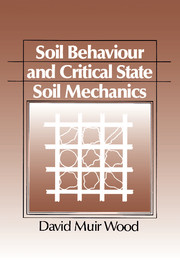Book contents
- Frontmatter
- Dedication
- Contents
- Preface
- Acknowledgements
- List of symbols
- 1 Introduction: models and soil mechanics
- 2 Elasticity
- 3 Plasticity and yielding
- 4 Elastic-plastic model for soil
- 5 A particular elastic—plastic model: Cam clay
- 6 Critical states
- 7 Strength of soils
- 8 Stress—dilatancy
- 9 Index properties
- 10 Stress paths and soil tests
- 11 Applications of elastic—plastic models
- 12 Beyond the simple models
- References
- Index
4 - Elastic-plastic model for soil
Published online by Cambridge University Press: 05 October 2014
- Frontmatter
- Dedication
- Contents
- Preface
- Acknowledgements
- List of symbols
- 1 Introduction: models and soil mechanics
- 2 Elasticity
- 3 Plasticity and yielding
- 4 Elastic-plastic model for soil
- 5 A particular elastic—plastic model: Cam clay
- 6 Critical states
- 7 Strength of soils
- 8 Stress—dilatancy
- 9 Index properties
- 10 Stress paths and soil tests
- 11 Applications of elastic—plastic models
- 12 Beyond the simple models
- References
- Index
Summary
Introduction
In this chapter we build a general but simple elastic-plastic model of soil behaviour, starting with the experimental observation of the existence of yield loci that was discussed in Chapter 3. Other features are added as necessary, and their selection is aided sometimes by our knowledge of well-known characteristics of soil response and at other times by knowledge of the elastic—plastic behaviour of metals.
Broadly, having established that yield surfaces exist for soils, it follows that, for stress changes inside a current yield surface, the response is elastic. As soon as a stress change engages a current yield surface, a combination of elastic and plastic responses occurs. It is necessary to decide on the nature of the plastic deformations: the magnitudes and relative magnitudes of various components of plastic deformation and the link between these magnitudes and the changing size of the yield surface.
It must be emphasised again that we are attempting to produce a simple broad-brush description of soil modelling which cannot hope to match all aspects of soil behaviour. Some of the shortcomings of such models are discussed in Chapter 12. For convenience of presentation, the discussion is largely restricted to combinations of stress and strain that can be applied in the triaxial apparatus, and the model is described in terms of triaxial stress variables p' and q and strain variables εp and εq.
- Type
- Chapter
- Information
- Soil Behaviour and Critical State Soil Mechanics , pp. 84 - 111Publisher: Cambridge University PressPrint publication year: 1991



